Continuing from the last post and impressions coming out of the first week of use! My notes on the Oppo Reno 10x Zoom will be coming out of a head to head comparison with the Samsung Galaxy Note 9.
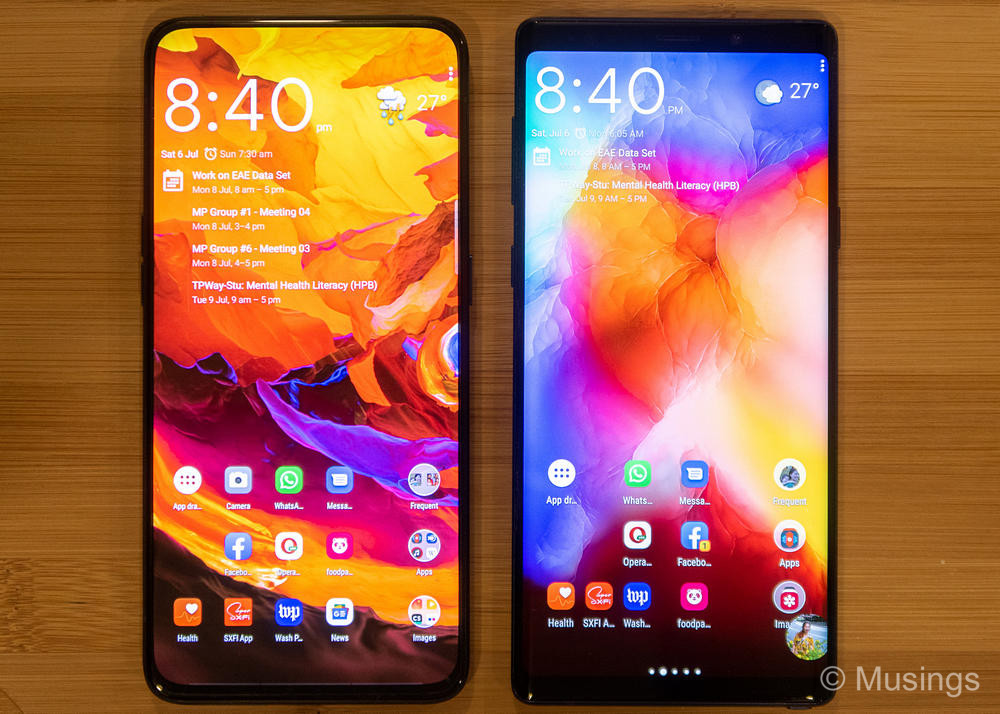
Design-wise: this is a large phone, though with the continuing advancements in camera optics and the trend towards bezel-less phones, a phone with a large display is, today, simply smaller in overall size than a similar item from say even 2 years ago. Basically, the Oppo Reno (10x Zoom) is just very slightly taller than the Samsung Note 9, and if you can handle the latter’s girth and height, you’ll have no problems with this one.
I’ve also had mixed feelings about the exteriors of mainstream phone manufacturers in general. The trend today for the mid-range and top-line phones is typically a high-spec Corning Gorilla Glass for the front, and a slightly lower grade Gorilla Glass layer for the back. The mid-rangers, e.g. Samsung’s A70 and A80, use glossy backs that attract fingerprints easily. That’s a non-issue if you routinely put your phone in a protective case, but still. I was thus glad to see that the Ocean Green variant I chose for the Oppo Reno uses an attractive matte finishing for its Gorilla Glass back. Even if you don’t put your phone in a case, you won’t at least have to constantly wipe the phone on your pants just to clean off your fingerprints.
To be sure though, Gorilla Glass will not protect you from micro-scratches, and just might not either for drops from height (though luck really does play a part in this) – both of my last two Samsung Galaxy phones picked-up scratches on the supposedly Gorilla Glass protected displays within days of purchase. So, you’ll still want to install an additional layer of screen protection – whether film or tempered glass – particularly if you’d thinking of reselling the phone at some point.
The Oppo Reno also has nice little touches that show the thoughtfulness of the phone designers and their wanting to differentiate their phone from the rest of the crowd. For instance, there’s a ‘O’ dot bump that elevates the back of the camera slightly, and thus offering some protection to the camera and lens array from scratches when the phone lying on surfaces. Secondly, the power button is slightly illuminated with a green light. I’m not sure what’s the intended utility behind this – perhaps for those of us who’re eyesight challenged and want to see where the power button is when in the dark – but it’s looks cool at least! Both features are, again, not particularly relevant if you put the phone in a protective case, but it really does make the phone feel just that bit different and premium.
The Oppo Reno is also equipped with the Snapdragon 855 chipset, currently one of the industry’s top performing SOCs. This inclusion is a nice to have for how I use my smartphones. But I don’t play mobile games on my smartphones, and the Android operating systems of today are way more fluid and responsive than they were five years ago. This new phone feels as responsive as the Note 9, with selected performance comparison tests done in numerous reviews also revealing that the Snapdragon 855 is roughly at least around 20% faster than the Snapdragon 845 on the Note 9. E.g. Phone Arena’s AnTuTu performance benchmark reports a score of 356150 vs 244787. Oddly though, the Chronus Home & Lock widget on the Oppo Reno seems to reload each time the phone comes out of standby mode. This is likely the result of a power optimisation setting somewhere in the phone that might had been enabled by default.
I was also initially sceptical of the Oppo Reno’s under display fingerprint sensor. But wow – the thing works like a charm. It’s as responsive as the types that are mounted on the power-button – like the last generation iPhones – or on the back of the phone, like on the Note 9. The Oppo Reno recognises my fingerprints and unlocks without hesitation each time. The phone also doesn’t have the Iris-unlock that the Note 9 has, but its face unlock – somewhat insecure as it is – also works great, with the shark fin camera popping out quickly to log you in, then retracting in a single smooth motion. What’s missing on the Oppo Reno though is the pattern unlock – a staple of Samsung phones – though I hope that can be included into a software update at some point.
Looking at both phones’ displays; putting aside that the Samsung Note 9 has a 6.4” vs the Oppo Reno’s 6.6” screens and that both are AMOLED types, the former is technically a superior display. It’s a QHD vs FHD+ resolution, and the Note 9 can simply put more information each screen than the Oppo Reno can… normally. Here’s a quick n’ dirty comparison of the amount of context the Samsung (top picture) puts out compared to the Oppo (bottom picture) on Facebook and Opera-Mini:
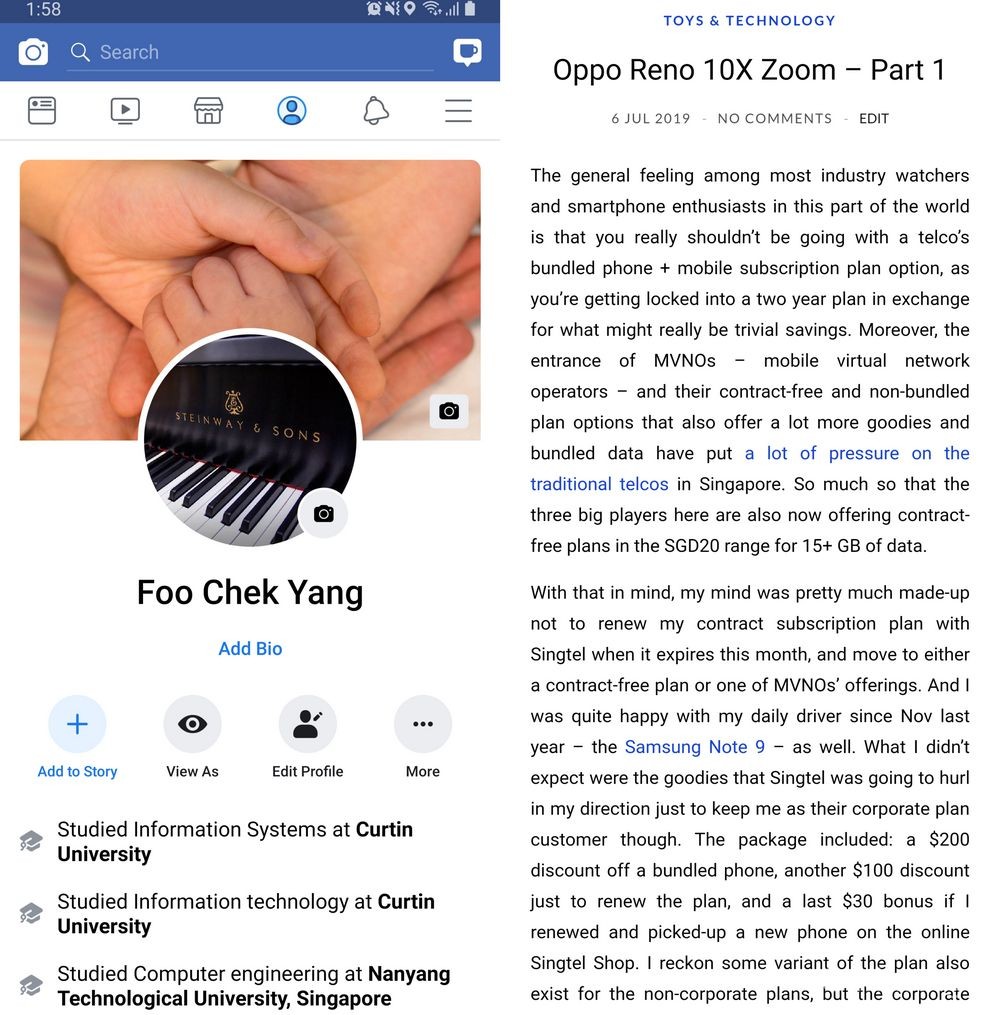
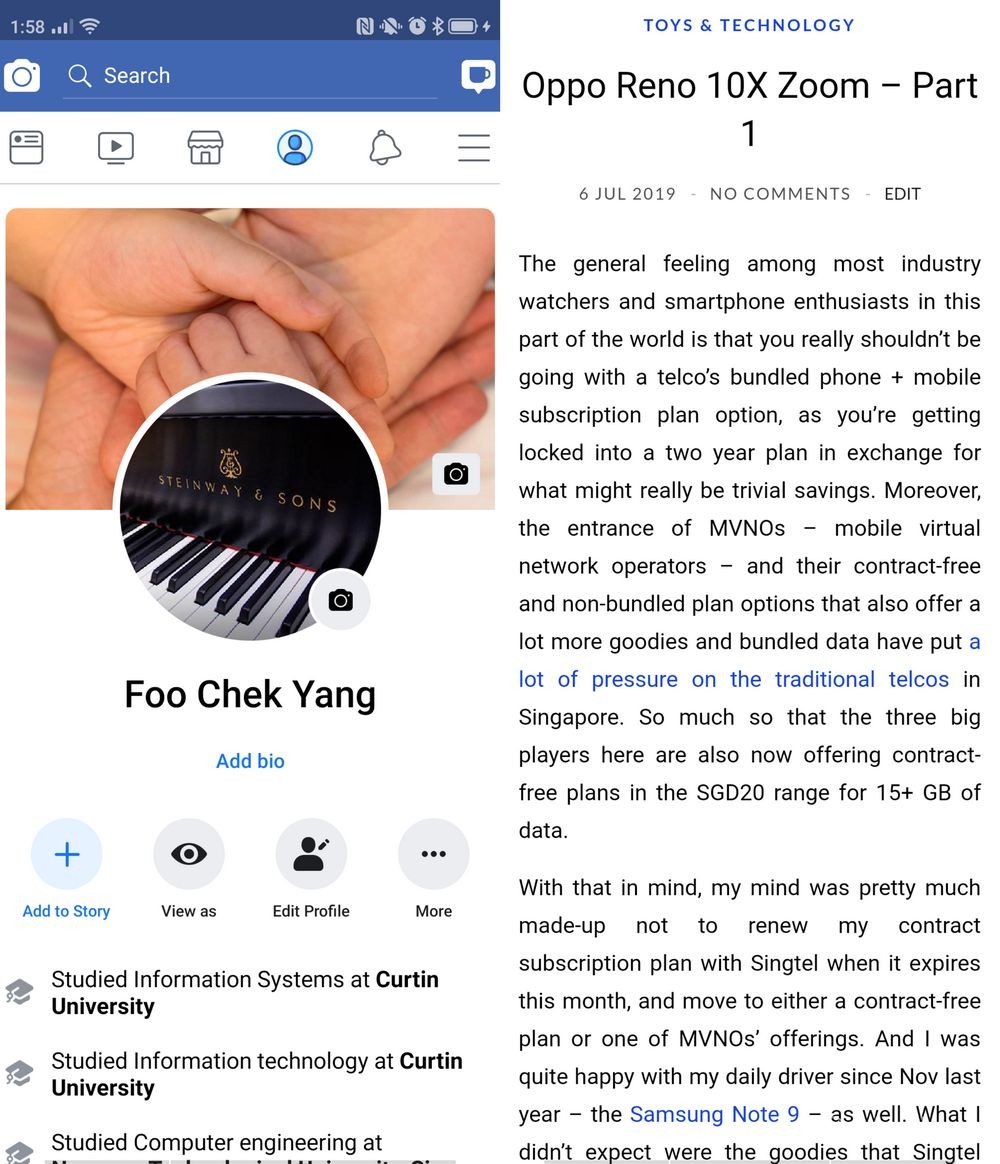
So, from a first look, the QHD+ resolution on the Note 9 will allow for just that more text to be displayed: compared against the Oppo Reno, I’ll put the Note 9 at very roughly an additional +5% or so for Facebook screen shot, and around +20% for the web page. However, the Oppo also has an additional display setting that lets you set zoom levels on the display. When set to zoom out, this has the effect of cramming even more material on the screen. And since the Oppo’s display is just that bit larger than the Samsung’s, it’s possible to reach a point of text-size approximation on both phones to again compare how much material both phones can show:
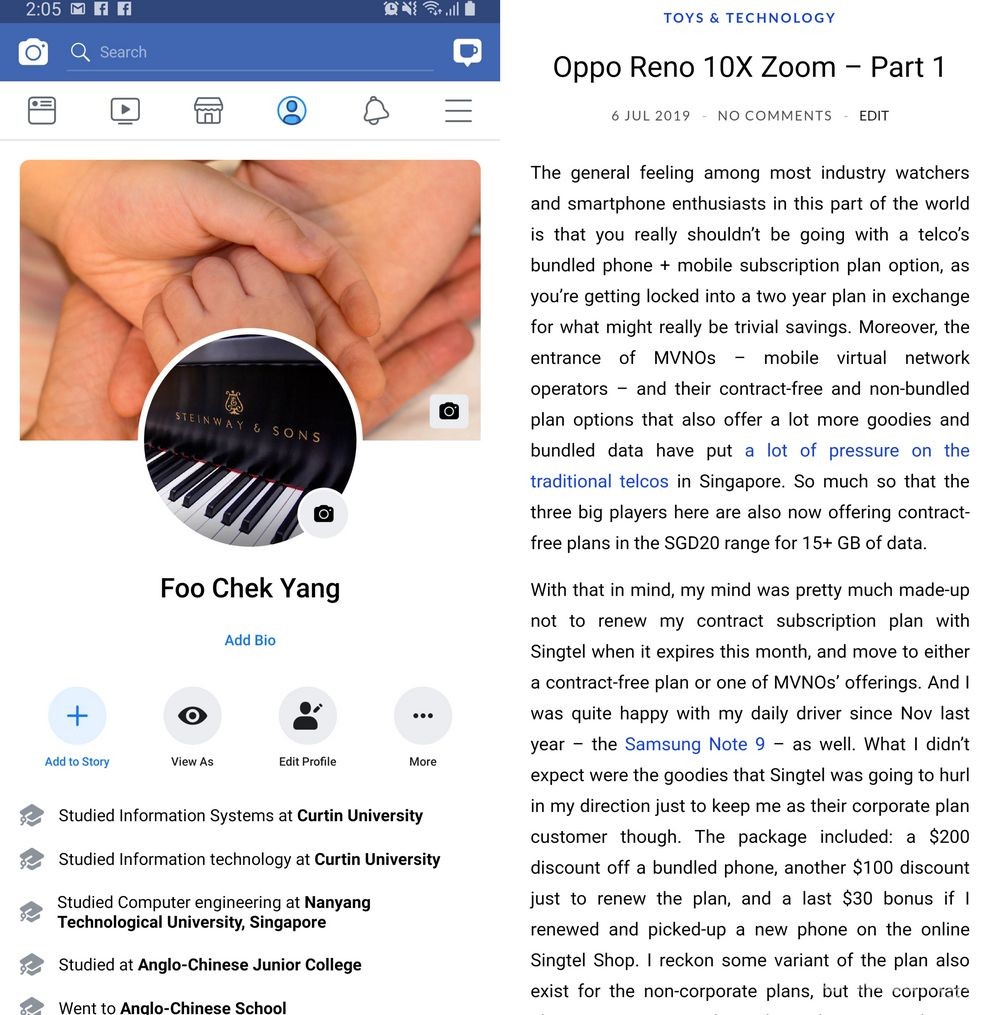
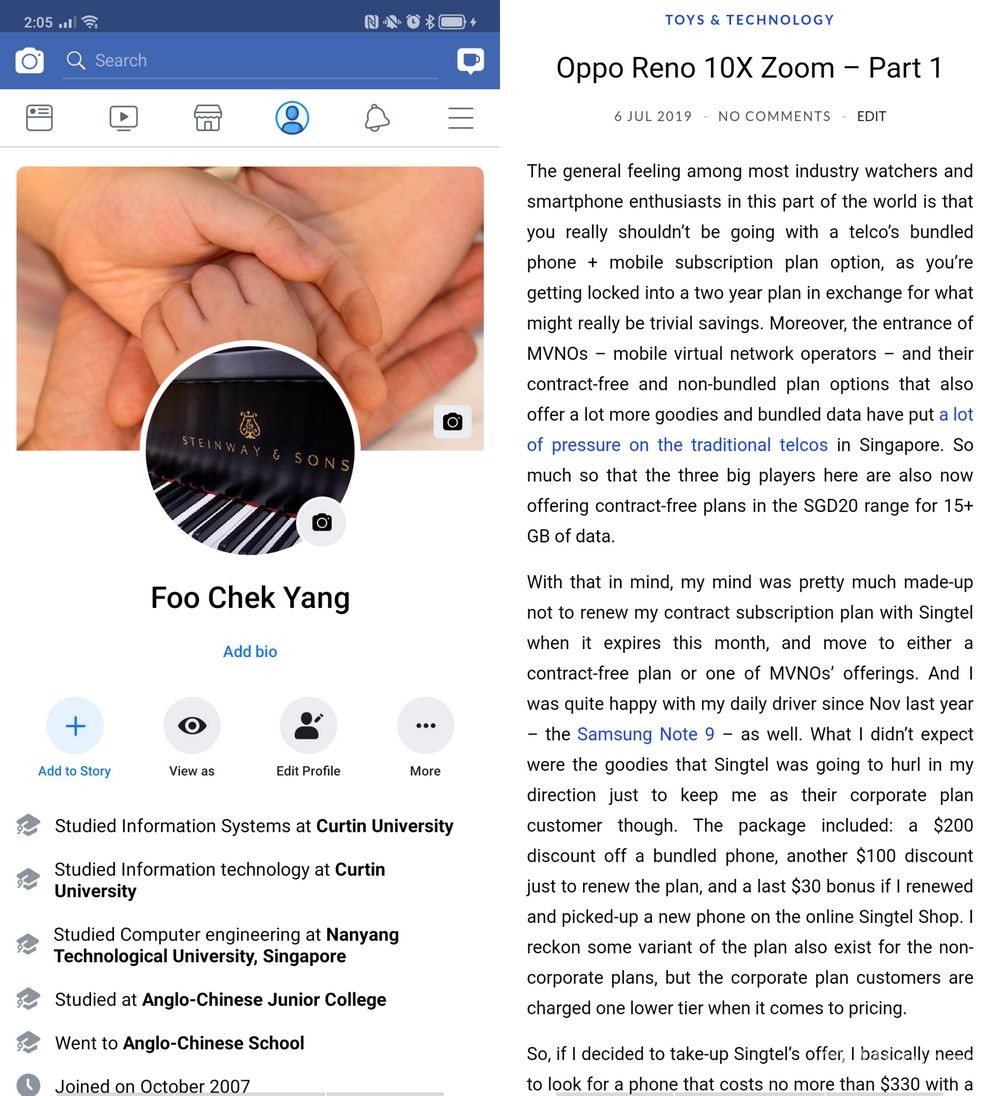
Not that the smallest font and/or zoomed out display on either phones make for very comfortable viewing for long periods of course, nor is this a particularly technically-grounded comparison. But it’s interesting nonetheless to see that a QHD+ resolution doesn’t necessarily mean that you will always get to see more content displayed on a screen compared to a FHD+ display. What can impact that, apparently, is also the underlining software controls, and also the size of the display the phone has to work with – and the Oppo Reno has the advantage here.
Even with my old flower eyes, the better contrast level on the Note 9 is observable to me. Its higher maximum brightness of 700+ nits vs 414 nits on the Oppo also makes the Note 9’s display more readable when used outdoors in bright daylight. Moreover, the corner edges of the Oppo Reno are also significantly more curved than the Note 9’s. I’ve never quite understood the industry’s fascination with phones with curved edges – I’d far rather a phone with squarish edges and displays that don’t curve around its corners. Basically, depending on what’s on the display, you can lose a bit of information at the corners on the Oppo Reno.

On the flip side, the Oppo Reno has a notch-less display and minimal bezels. You might think nothing of it, but once you’ve made the transition to a phone with a screen to body ratio this high, it’s hard to go back to normal phones. Also, the Oppo’s display along its long edges don’t curve as much as the Note 9 – which helps in reducing the probability of accidental swipes, and also easier mounting of tempered glass-type protectors. In all, the Oppo Reno’s display is very good and I reckon the majority of owners will be happy with it.
Continued in the next post!
Recent comments